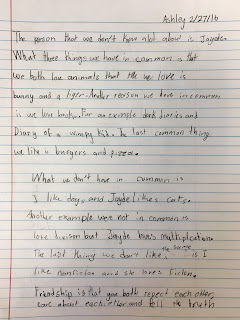Once the groups had had enough time to brainstorm, we came back together as a class and I recorded the students' thinking on an anchor chart. Some of their ideas sparked discussion. For example, the idea above that "good friends never tell on you" led to a debate. Many thought that they shouldn't tell on friends to show that they were loyal to their friends, but a few kids did bring up that there were certain situations that they would need to tell on a friend. It was a great discussion about safety within the topic of friendship. We ended up compromising and saying that friends "don't tell on you unless you are being unsafe or need help." We then hung it up on our Classroom Champions bulletin board to reference throughout the unit. Here are the ideas they came up with:
Our second lesson took place on Valentine's Day, which was perfect, as we were already celebrating friendship that day. The kids made friendship cinquains, which are five-line poems. I paired the students up with someone that they didn't normally hang out with so that they could get to know someone new. Each child had to interview their partner. They asked them questions such as what made them a good friend, what they liked to do, and traits that described them. Then, students wrote the poems about their partners. Many students commented that they learned something new about their partner, so hopefully this experience led to some new friendships!
The next week, we read a book called "Enemy Pie". It is about a boy who thinks he will never be friends with his enemy. His dad offers to help get rid of the enemy by making enemy pie. To distract the enemy, the boy has to play with him all day. Of course, by the end of the day, the two boys are no longer enemies but friends. After reading this book, we talked about many aspects of friendship. We reviewed the qualities of a good friend, then specifically talked about character traits that the students had that made them good friends. We also talked about reasons why they might stop being friends with someone. Finally, we discussed how enemies were usually just people that hadn't been given a chance yet to be friends. To conclude the lesson, the students each chose a friend to make a friendship web about. We have been learning about main idea webs in language arts, so this was a great chance to tie together two subjects. The students had to write their friend's name in the middle, and then connect it to reasons why that person was a great friend.
After making the friendship webs, the students got into groups and had to make recipes for good friends. To do this, they had to work together to determine the most important qualities in a friend. Then, they had to be creative and use those qualities to write a recipe (another thing we have been learning about in language arts!). Their recipes were very creative and they enjoyed sharing them with the class.
To finish the topic of friendship, we watched Alex Rigsby's video. The students loved listening to her advice about friendship and were eager to get started in meeting her challenge. To meet the challenge, I encouraged the kids to find a classmate that they did not know very well. I was surprised how quickly they did this and with no problems; I think that this month of focusing on friendship has helped them to be more open to new friendships. Once they were in pairs, they had to think about the goals they had set and then share them with their partner. They also had to work with their partner to think about why friendship is important. Their answers were very thoughtful.
Finally, the students chatted with their partners about their interests, and completed a venn diagram comparing and contrasting themselves. Many students were surprised to see that they had a lot in common with classmates that they did not know very well! They shared their venn diagrams with the class. Overall, I think the students enjoyed getting to know each other better this month and learning about ways to improve their friendships.





























